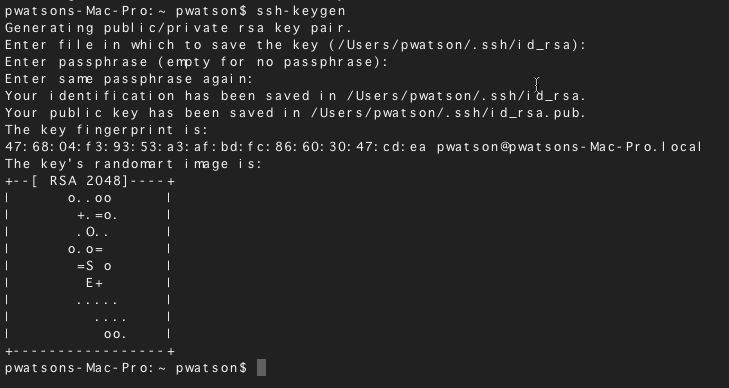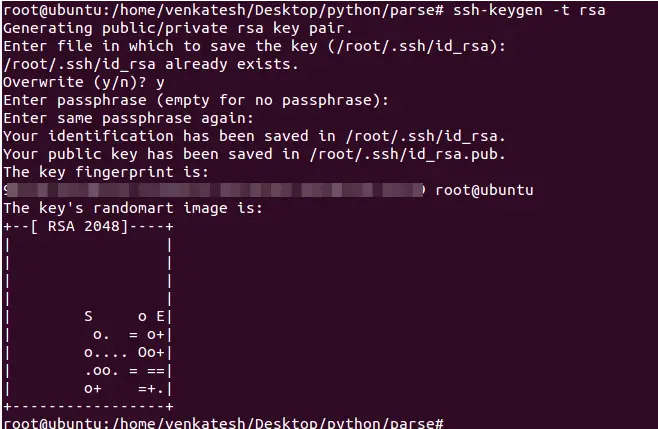Command To Generate Ssh Key
Posted : admin On 14.04.2020Overview
Public key authentication is a way of logging into an SSH/SFTP account using a cryptographic key rather than a password.
If you use very strong SSH/SFTP passwords, your accounts are already safe from brute force attacks. However, using public key authentication provides many benefits when working with multiple developers. For example, with SSH keys you can
I need to generate public key to set up in ssh. How do I do it from windows command prompt? I tried using ssh-keygen -t rsa from c: but received a message ssh-keygen is not recognized as an internal or external command, operable program or batch file. With both Tectia SSH and OpenSSH servers, access to an account is granted by adding the public key to a /.ssh/authorizedkeys file on the server. To install the public key, Log into the server, edit the authorizedkeys file with your favorite editor, and cut-and-paste the public key output by the above command to the authorizedkeys file. Before adding a new SSH key to the ssh-agent to manage your keys, you should have checked for existing SSH keys and generated a new SSH key. When adding your SSH key to the agent, use the default macOS ssh-add command, and not an application installed by macports, homebrew, or some other external source.
- allow multiple developers to log in as the same system user without having to share a single password between them;
- revoke a single developer's access without revoking access by other developers; and
- make it easier for a single developer to log in to many accounts without needing to manage many different passwords.
How Public Key Authentication Works
Keys come in pairs of a public key and a private key. Each key pair is unique, and the two keys work together.
These two keys have a very special and beautiful mathematical property: if you have the private key, you can prove you have it without showing what it is. It's like proving you know a password without having to show someone the password.
Public key authentication works like this:
- Generate a key pair.
- Give someone (or a server) the public key.
- Later, anytime you want to authenticate, the person (or the server) asks you to prove you have the private key that corresponds to the public key.
- You prove you have the private key.
You don't have to do the math or implement the key exchange yourself. The SSH server and client programs take care of this for you.

Generate an SSH Key Pair
You should generate your key pair on your laptop, not on your server. All Mac and Linux systems include a command called ssh-keygen that will generate a new key pair.
If you're using Windows, you can generate the keys on your server. Just remember to copy your keys to your laptop and delete your private key from the server after you've generated it.
To generate an SSH key pair, run the command ssh-keygen.
It will look like this when you run it:
You'll be prompted to choose the location to store the keys. The default location is good unless you already have a key. Press Enter to choose the default location.
Next, you'll be asked to choose a password. Using a password means a password will be required to use the private key. It's a good idea to use a password on your private key.
After you choose a password, your public and private keys will be generated. There will be two different files. The one named id_rsa is your private key. The one named id_rsa.pub is your public key.
You'll also be shown a fingerprint and 'visual fingerprint' of your key. You do not need to save these.
Configure an SSH/SFTP User for Your Key
Method 1: Using ssh-copy-id
Now that you have an SSH key pair, you're ready to configure your app's system user so you can SSH or SFTP in using your private key.
To copy your public key to your server, run the following command. Be sure to replace 'x.x.x.x' with your server's IP address and SYSUSER with the name of the the system user your app belongs to.

Method 2: Manual Configuration
If you don't have the ssh-copy-id command (for example, if you are using Windows), you can instead SSH in to your server and manually create the .ssh/authorized_keys file so it contains your public key.
First, run the following commands to make create the file with the correct permissions.
Next, edit the file .ssh/authorized_keys using your preferred editor. Copy and paste your id_rsa.pub file into the file.
Log In Using Your Private Key
You can now SSH or SFTP into your server using your private key. From the command line, you can use:
Clip Studio Paint Key 2020 Download. With all the features and tools of Clip Studio Paint Key, you can easily make great effects and drawings. Furthermore, it has rulers for basic drawings as well as it offers a variety of rulers including perspective ruler that allows you to add perspective to the background. Clip studio paint 1.8.5 key generator for windows 10. Clip Studio Paint EX 1.8.5 Crack is the best comics and manga creation software in the world and gives powerful drawing tools for each comic and manga writers. It is designed both for artists who want to improve and perfect their paper and pencil illustrations and for artists who wish to complete the whole process of creating manga and comics digitally. Clip Studio Paint 1.8.5 Crack 2020 With Torrent Full Download Latest. Windows 10 Product Key With Key Generator Updated 2020 Latest Ver. PowerISO 2020 Crack Full Version And New License Key Latest Copy Leave a Reply Cancel reply. Your email address will not be published.
If you didn't create your key in the default location, you'll need to specify the location:
If you're using a Windows SSH client, such as PuTTy, look in the configuration settings to specify the path to your private key.
Granting Access to Multiple Keys
The .ssh/authorized_keys file you created above uses a very simple format: it can contain many keys as long as you put one key on each line in the file.
If you have multiple keys (for example, one on each of your laptops) or multiple developers you need to grant access to, just follow the same instructions above using ssh-copy-id or manually editing the file to paste in additional keys, one on each line.
When you're done, the .ssh/authorized_keys file will look something like this (don't copy this, use your own public keys):
Additional Information
Retrieve Your Public Key from Your Private Key
The following command will retrieve the public key from a private key:
This can be useful, for example, if your server provider generated your SSH key for you and you were only able to download the private key portion of the key pair.
Ssh Generate Key Pair
Note that you cannot retrieve the private key if you only have the public key.
Eset nod32 serial key generator. Along these lines, the unwanted viruses can not enter your PC, while using this. This is a brilliant security programming for Mac and Windows. Additionally, it is a uniqueness in this device, you will recognize it and furnish you with a danger notice.
Correcting Permissions on the .ssh Directory
The instructions in this article will create your server's .ssh directory and .ssh/authorized_keys file with the correct permissions. However, if you've created them yourself and need to fix permissions, you can run the following commands on your server while SSH'd in as your app's system user.
Disabling Password Authentication
NOTE: When changing anything about the way SSH is accessed(ports, authentication methods, et cetera), it is very strongly recommended to leave an active root SSH session open until everything is working as intended. This ensures you have a way to revert changes in the event something goes wrongand logins are not working properly.
As an extra security precaution, once you have set up SSH keys, you may wish to disable password authentication entirely. This will mean no users will be able to log into SSH or SFTP without SSH keys. Anyone entering a password will receive a message like:
Command To Generate Ssh Key
Or:
Disabling password authentication is an excellent way to improve server security. Please see our guide here for the steps to accomplish this goal.
Then, test whether you're able to log in with a password by opening a new SSH or SFTP session to the server. Passwords should not be able to be used and, if everything has been done correctly, an error will be issued when someone tries to use a password. Unless this setting is changed back to allow password authentication, no users will be able to log in without an SSH key set up.